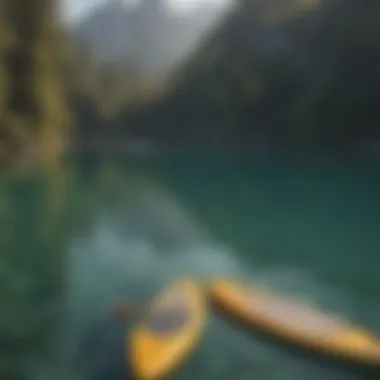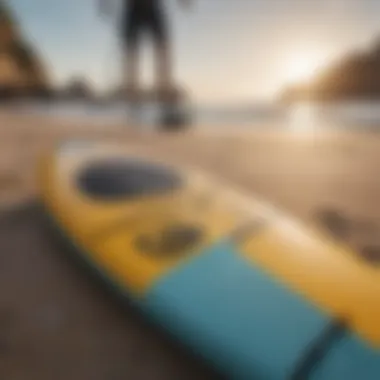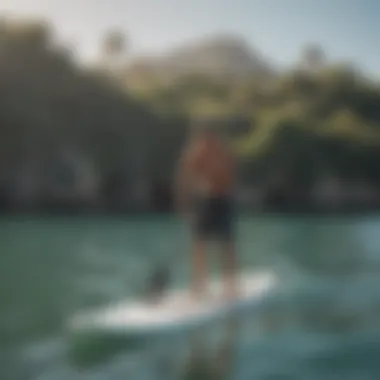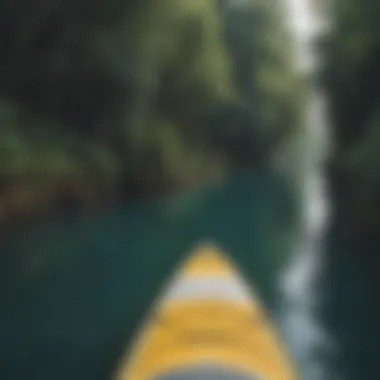Starting Your Paddle Boarding Experience


Intro
Starting a paddle boarding journey can feel a bit like taking your first steps into an uncharted territory. Whether you’re drawn to the calm lakes or the roaring ocean waves, there’s a unique thrill awaiting those who are willing to embrace it. Paddle boarding is not just a sport; it's an adventure that connects you with nature while also offering a chance to recharge your mental batteries. This guide will walk you through the essential elements of paddle boarding, ensuring you feel ready and excited for your experience.
Surf Gear and Equipment
In any new activity, the right gear goes a long way. Paddle boarding is no different. You wouldn’t venture into the woods without sturdy boots, nor should you hit the water without the proper equipment.
Latest Surfboard Technologies
When choosing a paddle board, you'll encounter various types tailored for different water conditions and user preferences. For instance, inflatable paddle boards have gained popularity for their portability and ease of storage. Modern designs utilize high-quality materials that offer durability and performance comparable to traditional solid boards. Familiar brands like Red Paddle Co. and iROCKER provide an array of options to suit beginners and advanced users alike.
Key Features to Look For:
- Size: Longer boards track straighter, while wider boards provide stability.
- Material: The construction affects weight, buoyancy, and durability.
- Shape: This dictates how the board handles waves and paddling efficiency.
Essential Accessories for Surfers
Having the right accessories can make a world of difference in your paddle boarding experience. Here’s what you should consider:
- Paddle: The right paddle is crucial for efficiency. Adjustable paddles cater to various heights, making them a versatile choice.
- Life Vest: Safety should never be compromised. A well-fitted life vest should be worn at all times going out on the water.
- Leash: This keeps your board close. If you fall, you’ll be able to grab it quickly instead of chasing it down.
- Dry Bag: To keep your valuables safe and dry, especially if you’re planning to explore coastal areas.
"The right gear doesn’t just enhance your experience; it ensures your safety on the water."
Techniques and Skills
After gathering the necessary equipment, it’s time to hop on the board. But don’t rush in. Starting with the right techniques can save you from frustration and injury.
Wave Riding Strategies
Before paddling into the waves, familiarize yourself with proper positioning and balance. Always position your feet shoulder-width apart, bending your knees slightly for that lower center of gravity. When riding waves, angle your board toward the breaking curl to ride it smoothly. Here's a quick breakdown:
- Positioning: Stand with feet aligned and knees bent.
- Paddling: Use long, even strokes to maintain speed.
- Turning: Shift your weight and pivot at the tail for easier maneuvering.
Safety and Surf Etiquette
Safety is paramount in all water sports, and understanding how to share the waves is also essential. Always be aware of your surroundings. Look out for others paddling, swimmers, or boats. Respecting each other in the water extends to executing proper etiquette:
- Communication: If you're approaching someone, a quick shout can alert them.
- Right of Way: The person closest to the wave has priority—so don’t drop in on others.
- Avoid Crowding: Give people space, especially beginners who might be more cautious.
Diving into paddle boarding is a journey that combines thrill and tranquility. Equipped with the right gear and skills, you’ll gradually find your rhythm on the water, experiencing both the joys of exploration and a deeper connection to the environment around you.
As you continue your adventure, remember to reflect on the moments that bring you peace and joy on this journey.
Understanding Paddle Boarding
Paddle boarding has gained traction as a favored water sport, capturing the hearts of surfers, outdoor enthusiasts, and lifestyle bloggers. This section dives into the essence of paddle boarding, shedding light on its definition, historical backdrop, and what’s shaping the landscape today.
Defining Paddle Boarding
Paddle boarding, in its simplest terms, involves standing on a large board and using a paddle to propel oneself through the water. While this might sound straightforward, the sport encapsulates more than just gliding across serene lakes or catching waves. It emphasizes connection with nature, enhances one’s fitness, and provides a thrilling yet peaceful experience. The balance you must maintain while paddling becomes a metaphor for life itself—a delicate act of equilibrium amid shifting currents and breezes.
Historical Context
The origins of paddle boarding trace back centuries. Cultures like the Polynesians used similar techniques for fishing and transportation across the Pacific. The modern iteration, however, stems from the Hawaiian Islands in the 1960s when surfers began using longer boards to catch waves more effectively and teach aspiring surfers in the shallows. What began as a practical approach has now evolved into a widespread recreational activity, loved globally for its accessibility and versatility.
Current Trends in Paddle Boarding
Today, paddle boarding boasts a rich tapestry of trends. Stand-up paddle boarding (SUP) classes are sprouting up in various locales, accommodating everyone from novices to seasoned pros. Furthermore, themed paddle boarding events are becoming increasingly popular—yoga sessions on boards, sunset paddles, and even eco-tours that educate participants about local ecosystems.
Interestingly, there’s a growing emphasis on environmentally conscious paddle boarding practices. Enthusiasts are advocating for gear made from sustainable materials and supporting initiatives aimed at protecting marine wildlife. In a world grappling with climate change, paddle boarders are stepping up, combining their love for the sport with a mission to safeguard our oceans.
"Paddle boarding isn’t just a sport; it’s a lifestyle, a way to embrace the outdoors while being mindful of the earth beneath our feet and the waters we glide over."
This understanding of paddle boarding encompasses its multifaceted nature—combining fun, fitness, environmental responsibility, and rich cultural history. By grasping these fundamentals, aspiring paddlers can appreciate what lies ahead as they embark on their own journey in this exhilarating sport.
Essential Equipment for Beginners
When diving into the world of paddle boarding, having the right equipment isn't just a luxury; it’s a necessity. The right gear can help you avoid unnecessary frustrations and make your time on the water not only safer but also more enjoyable. Whether you are just testing the waters or looking to glide into a new passion, understanding your equipment will lay the foundation for a successful start.
Choosing the Right Paddle Board
Different Types of Boards
Choosing a paddle board is like trying to find the right ice cream flavor—there's just so much out there, and it can be overwhelming. There are primarily three types of boards you might consider: all-around, touring, and surfing boards. Each has its own charm and use case. The all-around boards are versatile, making them a popular choice for beginners.
What makes all-around boards a favorite is their stable construction, which provides a good sense of balance. They are generally wider and thicker, allowing for balance even if you're just starting out. However, if you find a passion for speed, getting a touring paddle board can be your next step. These are longer, offering faster rides on flat water and perfect for longer distances, but they may be trickier to balance on initially. Remember, each board type has its perks and drawbacks, so it pays to understand what suits your paddle boarding goals.
Size and Volume Considerations
When you’re picking a board, size and volume play crucial roles. The length can determine how swiftly you glide through water, while the volume impacts how stable the board feels. A thicker board might keep you afloat better, but you don't want it so broad that it feels like steering a ship.
For beginners, a board with a volume that matches your weight will prevent you from sinking like a stone. Think of it like finding the right pair of shoes; it needs to fit well to walk comfortably! However, bigger isn’t always better. A board that is too big can become cumbersome to maneuver, particularly for new paddlers still finding their sea legs.
Material Options
The material your paddle board is made of can greatly affect its performance and durability. Inflatable boards are often marketed to beginners because they're light and easy to transport. They can be rolled up and stuffed in your car trunk, making them incredibly convenient. However, softer surfaces mean they're generally less rigid and might not track as straight on the water.
On the other hand, hard boards are made usually of fiberglass or epoxy, providing increased stability and speed. Although they’re a bit of a handful to lug around, they might just be worth it as your skills grow. Think about storage, transport, and your intended use when deciding between materials—they all have their ups and downs.
Selecting Appropriate Paddles


Materials
Just as crucial as the board itself, paddles come in various materials that impact performance. You might find paddles made from aluminum, fiberglass, or carbon fiber—each tailored for different needs. Aluminum paddles are sturdy and budget-friendly, making them a common choice among beginners.
However, they aren't the lightest. If you're looking for efficiency and lightweight options, the fiberglass paddles are a step up. They provide a nice balance between weight and cost, but if you're aiming for the ultimate performance, carbon fiber is the crème de la crème. This material is light and offers excellent stiffness, but the price tag may make you think twice.
Length and Design
The length and design of the paddle impact your stroke efficiency. A general rule of thumb is to choose a paddle that is approximately 8 to 10 inches taller than you. This ensures a comfortable grip without needing to stretch like you're prepping for a yoga class.
Curved paddles, known as dihedral, can slice through the water effortlessly. Straight paddles are less complex but could require more energy to paddle. It’s about finding the right design that aligns with your technique and comfort level as you hit the water.
Weight Considerations
Finally, the weight of the paddle is essential, especially for those looking to paddle long distances. Heavier paddles can wear you out faster, making your time on the board less enjoyable. Lightweight paddles allow for longer excursions without wearing out, which is exactly what you'd want as you create memories on the water.
Safety Gear and Accessories
Personal Floatation Devices
Safety gear is like the perfect life jacket on the high seas—it might look boring, but it’s crucial. Personal flotation devices (PFDs) are not just a mere suggestion; they’re often legally required for paddle boarding. Choose a well-fitting vest to keep you buoyant. A comfortable PFD allows ease of movement, making it less likely that you'll treat it like a punishment.
More advanced PFDs come with extra features like pockets, offering a place to store snacks or your phone. Just keep in mind that a cooler safety vest won't substitute skill or caution, but it can help keep you afloat if things take a turn.
Leashes and Lights
Next up, leashes are a simple accessory yet incredibly vital. A leash keeps you connected to your paddle board; without it, your board could drift away faster than you can swim. Opt for a coiled leash that doesn’t drag in the water, ensuring smooth paddling without the hassle.
If you find yourself paddling at dusk or dawn, consider adding lights. They improve visibility and let others know you’re out on the water. Safety first!
Proper Apparel
Lastly, the right apparel can turn a great day on the water into an exceptional one. Think moisture-wicking materials that keep you dry and comfortable, especially during warm afternoons. A good pair of water shoes is also a lifesaver—nobody enjoys sharp shells or slimy rocks underfoot.
Consider a lightweight long-sleeve shirt for sun protection to avoid getting burnt. Look for garment options that are breathable and quick-drying. In the end, the right apparel keeps you comfy so you can focus on enjoying the ride instead of nursing sunburns.
"The right gear doesn’t make the paddler, but it certainly makes the paddle far more enjoyable."
Mastering Basic Techniques
Mastering the art of paddle boarding involves more than just standing on a board and paddling. It is the foundation that can make or break your experience on the water. Developing these basic techniques ensures you won’t just float along, but that you have the confidence and control to truly enjoy every moment.
Learning proper techniques can enhance your efficiency, making your paddles smoother and your outings safer. When you master these skills, you’ll find yourself able to navigate various conditions, adjust to fast currents, or simply enjoy a peaceful glide across a calm lake. This section is all about providing you the key tools to thrive on your paddle boarding journey.
Getting on the Board
Initial Positioning
Initial positioning is essential for balance right from the start. It sets the stage for everything that follows. When beginners hop aboard, they often find it tricky to figure out where to place their feet. A key characteristic of good initial positioning is to have your feet shoulder-width apart, centered over the board’s middle. This stance contributes significantly to your overall stability.
Choosing to start in this position is highly beneficial because it keeps your center of gravity low. It helps reduce the chances of tipping over. A unique feature of initial positioning involves finding your "sweet spot" on the board, as each paddle board has its own balance point. Understanding this is vital because if you're positioned too far back or forward, you can easily lose balance, leading to unexpected falls—even in calm water.
Balancing Techniques
Once you have a solid initial positioning, the next step is mastering balancing techniques. Balance may seem simple, but it’s a crucial aspect that many newcomers struggle with. One of the key characteristics of effective balancing is being aware of your body’s movements. To stay upright, it is essential to keep your core engaged. This technique makes you flexible to shifts in weight and helps you adjust to unexpected movements of the board, like when a wave hits.
A standout feature of balancing techniques is the importance of being adaptable. Whether you’re standing still or moving, having good balance can significantly ease your paddling experience. It directly impacts your control over the board, allowing smoother strokes and reducing energy spent trying to stay upright. On the downside, if you neglect to practice balance, it can lead to fatigue and frustration, especially during longer paddles.
Paddling Techniques
Strokes Explained
An understanding of various strokes is fundamental to effective paddling. Strokes explained covers everything from the forward stroke to the reverse and sweep strokes. The key characteristic of effective paddling is its ability to propel your board with less effort. When executed correctly, the forward stroke can be surprisingly efficient, enabling you to cover distances without exhausting every last bit of energy.
The stroke's unique feature lies in its mechanics—thinking about how your paddle enters and exits the water can hugely affect your momentum. Beginners often tend to use too much energy with broad strokes, leading to inefficient paddling. On the flip side, mastering this technique means you’ll have a more enjoyable experience, gliding along rather than battling against the water.
Effective Speed Control
Speed plays a vital role in paddle boarding. Effective speed control is essential for navigating different situations on the water. A key characteristic of speed control involves knowing when to apply power versus when to ease off. This skill is particularly useful when you're moving through turbulent or crowded areas.
A unique element of this technique is the ability to adjust your paddle strokes, which can help maintain a consistent speed. On a beneficial note, learning to control your speed allows for a smoother ride. However, if you struggle with it, you may end up slowing down unexpectedly or, conversely, rushing through challenging situations, potentially leading to mishaps.
Turning Strategies
Skillful maneuverability on the water is the name of the game, and turning strategies can make all the difference. This section covers techniques like the pivot turn or sweep turn. The key characteristic of effective turning is the swift adjustment of your paddle position.
Having a grasp of these skills means you can change directions quickly without needing to stop. A turning strategy's unique aspect lies in its ability to keep you engaged with the water's dynamics. You might find this valuable when navigating winding rivers or open waters where direction changes are frequent. Failing to develop solid turning strategies may lead to unnecessary paddling or even collisions, especially in crowded spots.
Navigating Different Water Conditions
Flat Water vs. Choppy Conditions
Understanding the differences between flat water and choppy conditions is an aspect that every paddler should be aware of. Flat water provides an easier experience, while choppy water can challenge your skills. The key characteristic of flat water is its predictability, allowing for smoother paddling and fewer disturbances.
The unique feature of choppy conditions, however, lies in the learning opportunities they present. Paddling in these waters can improve your balance and paddling techniques, making you a more versatile paddler. But, it’s essential to note that without adequate preparation, choppy conditions can also lead to frustrating situations or more significant risks. Thus, being adaptable is crucial.
Dealing with Currents and Tides
Currents and tides can seem intimidating to newcomers, but knowing how to deal with them is one of the essential skills of mastering paddle boarding. A key characteristic of effectively navigating these conditions lies in understanding the water's flow. It’s beneficial because it allows you to paddle efficiently and can even give you a boost during your outings.
Unique features of navigating currents include shifting your angle while paddling to maintain a straight line and using the environment to your advantage. However, misjudging a current can lead you off course or, worst-case scenario, into dangerous situations. Understanding these aspects helps keep your paddle boarding experiences safe and enjoyable, ensuring that you make the most of your time on the water.


Safety Considerations
When stepping into the world of paddle boarding, prioritizing safety cannot be overstated. It’s not only about ensuring a good time on the water, but also about protecting yourself and those around you. Diving deep into safety considerations helps beginners recognize potential risks while equipping them with tools to manage various waterborne scenarios. Understanding these elements provides peace of mind and enhances the overall paddle boarding experience.
Understanding Local Water Regulations
Each waterway has its own set of regulations, and knowing these is paramount. Local water regulations can include rules regarding where you can paddle, speed limits, and necessary permits for usage. Not adhering to these can lead to fines or, worse, dangerous situations. Moreover, local rules often reflect specific safety measures tailored to the area’s conditions.
To navigate this landscape effectively, beginners should:
- Check local water authority websites for detailed regulations.
- Talk to experienced paddle boarders in the area who can share insights.
- Familiarize themselves with any seasonal restrictions that may affect accessibility.
Understanding these regulations fosters a sense of responsibility and respect for the environment you’re navigating.
Weather Awareness
Monitoring the weather is just as crucial as understanding safety regulations. Conditions can shift quicker than a cats tail in a dog park, leading to unexpected challenges. Knowing what’s on the horizon can prevent dangerous outings.
Monitoring Conditions
Monitoring conditions refers to keeping an eye on the weather patterns leading up to and during your paddle boarding adventure. This includes checking forecasts, wind speeds, and tide schedules. When you have this information, you can plan your trips accordingly, avoiding those gusty days when the wind is howling like a pack of wolves.
Key aspects of monitoring weather include:
- Utilizing reliable weather apps: Most have features tailored for outdoor sports, helping you understand when it’s safe to hit the water.
- Listening to advisories: These can alert you about sudden storms or changes in conditions. Ignoring these could lead to unfortunate mishaps.
- Observing nature: Changes in bird behavior or lake surface can signal shifts in weather patterns that apps might not catch.
With vigilant monitoring, you can enjoy your paddle boarding without the worry of mother nature throwing a curveball.
Recognizing Changing Weather Patterns
In addition to monitoring, recognizing changing weather patterns during your time on the water is key. This skill can be the difference between a blissful afternoon and a frantic rush to the shore. Awareness might manifest in noticing dark clouds rolling in or wind direction shifting unexpectedly, changes that can escalat into hazardous conditions.
It’s a wise strategy to:
- Be alert for visual cues: Black clouds can indicate approaching storms. If you’re out on the board, it’s better to err on the side of caution and head back.
- Heed local knowledge: Seasoned paddle boarders can provide invaluable insight into typical weather behaviors for particular areas.
- Commit to ongoing learning: As with any skill, the more you paddle, the more attuned you become to environmental signals.
Being aware allows for proactive decision-making, enhancing safety and ensuring a more enjoyable experience.
Emergency Preparedness
Although it’s easy to focus on the thrill of paddle boarding, being prepared for emergencies is an essential part of the equation. Having a plan in place will make all the difference, should things go south.
Emergency Protocols
Emergency protocols are a set of predetermined actions taken in the event of crises like an injury, gear failure, or sudden weather changes. Adopting these protocols is more than a good idea; it shows a readiness to tackle the unpredictability of outdoor sports.
Components to consider include:
- Establishing communication: Inform someone about your plans and check-in times. This way, someone is aware if you deviate from your plan.
- Creating a first-aid kit: It should include essentials like band-aids, antiseptic wipes, and any personal medications. Having a minor injury can escalate quicky without the right equipment.
- Crafting a return plan: If conditions worsen or if you're feeling unwell, what’s your plan to get back to shore? Ensure you have reliable means of navigating back.
These preparations not only safeguard your life, but enrich your paddle boarding journey.
Dealing with Capsizing
Even the most skilled paddlers can find themselves unexpectedly in the water. Dealing with capsizing is a vital skill to develop. Knowing how to respond can minimize any panic and keep you safe.
Key steps include:
- Staying calm: It might be tempting to flail about, but remaining composed can help you assess the situation effectively.
- Recovering your board: If you can, grab on to the board as it will help you stay afloat. Many boards are designed to provide buoyancy, making it a valuable asset.
- Swim to safety: Once you manage to get hold of the paddleboard, depending on the conditions, you may decide to swim to the shore. Make sure to keep your feet pointed down to avoid any unseen obstacles.
Understanding and practicing these emergency procedures will not only boost your confidence; it equips you to handle unpredictable scenarios, ensuring that your paddle boarding adventures can be as enjoyable and secure as possible.
Expanding Your Skills and Experience
Embarking on the paddle boarding journey is just the beginning, and as you dip your toes into the water, there's a world of further development awaiting you. Expanding your skills and experience is crucial; it not only enhances confidence on the water but also deepens your appreciation for the sport. This section delves into the opportunities for growth through learning from experts, joining communities, and exploring various locations.
Learning from Experts
Personal Coaching
Personal coaching can be a game changer on your paddle boarding path. Having a dedicated instructor helps hone your techniques right from the start, ensuring you're not picking up bad habits. The key characteristic here is the tailor-made feedback that comes with individualized sessions. With personal coaching, you can learn the nuances of paddling—like how to position your body correctly or how to navigate tricky waters with ease. Such guidance can significantly accelerate your learning curve, making it a popular choice among new paddle boarders.
However, this approach does come with its unique features and considerations. The primary advantage is the one-on-one attention, which promotes personalized learning. On the flip side, it may not suit everyone’s budget. Some might find that they learn just as effectively from group sessions or online resources. Nonetheless, if you seek intensive skill development, personal coaching is worth considering.
Online Resources and Tutorials
The digital age has paved the way for a treasure trove of online resources and tutorials. These resources allow you to learn at your own pace and on your schedule. They're often free or low-cost, which makes them accessible. Many platforms offer video tutorials that break down complex techniques into digestible snippets. While this approach is popular, it’s important to note that not all content is created equal; quality can vary widely.
A unique aspect of online tutorials is the vast array of topics they cover. From basic paddling strokes to advanced tricks, you're likely to find exactly what you need. However, one disadvantage is the lack of real-time feedback, which can lead to misunderstandings of techniques. Thus, while online resources can complement your learning, they are best used alongside practical experience.
Joining Local Paddle Boarding Communities
Meetups and Groups
Getting involved in local paddle boarding communities can vastly enhance your experience. Meetups and groups provide a valuable support network. They create a friendly atmosphere where you can learn from others and share tips. The social aspect is a big draw—paddle boarding with others can motivate you to improve and explore new locations.
These gatherings also foster a sense of belonging, especially for beginners who might feel overwhelmed. A notable feature of these groups is the shared experiences. You can gain insights from fellow paddlers who’ve faced similar challenges, making their guidance relatable. Nonetheless, participation may vary, and finding the right group that matches your skill level and goals is key. Some gatherings can become overly competitive, which might not be ideal for everyone.
Participating in Events and Competitions
Engaging in events and competitions can be another great way to expand your skills. Such activities present the chance to put your training into action while also testing your limits. The spirited competition pushes you to hone your techniques further, which can refine your skills dramatically.


Moreover, competitions often come with an engaging community vibe, where sharing experiences is encouraged. However, it’s essential to carefully evaluate whether the pressure of competition is motivating or intimidating for you. Some people thrive in competitive environments, while others may find it daunting. Consider your personality when delving into competitive events.
Exploring Diverse Locations
Shoreline vs. Open Water
Understanding the contrast between shoreline and open water paddling is crucial in expanding your paddle boarding experience. Each environment brings its own set of challenges and rewards. Paddling along the shoreline offers calm waters and a close-up look at picturesque coastlines. It’s an ideal setting for beginners looking to build confidence without waves crashing down.
Conversely, open water presents a different challenge altogether. It tests your skills and endurance as you navigate larger waves and potential currents. The key characteristic of open waters is the greater unpredictability, which can be thrilling for more experienced paddlers. However, it also requires a solid understanding of water conditions and safety practices.
Exploring both types of locations allows you to be versatile in your skills. Yet, it’s essential to assess comfort levels. Beginners should stick close to shorelines until they feel more confident.
Traveling for Paddle Boarding Adventures
Lastly, traveling for paddle boarding adventures can significantly expand your horizons. Whether it’s a day trip to a nearby lake or a weekend getaway to a beach destination, new locations introduce unique conditions and scenery. Different regions may offer various water types—some may have calm lakes while others boast more rugged coastlines.
Traveling not only enriches your skills but also cultivates a sense of adventure. Trying out paddle boarding in different environments can reveal fresh perspectives and inspire creativity. However, it’s important to conduct thorough research before diving into unfamiliar waters; knowing the local conditions and rules is crucial.
In summary, expanding your skills through various means not only enriches the paddle boarding experience but also helps integrate this rewarding activity into your lifestyle. Join the community, learn actively, and explore diverse domains—these elements are essential in building your confidence and expertise on the water.
Understanding the Environmental Impact
Paddle boarding can offer a refreshing connection with nature, yet it also comes with responsibilities toward our environment. Understanding the impact one has while enjoying the water is crucial. Not only does this knowledge promote conservation, but it also helps paddle boarders engage in practices that protect waterways and marine ecosystems.
Being mindful of the environment leads to sustainable adventures and preserves the natural beauty for future paddlers. As enthusiasts, we should appreciate the delicate balance of ecosystems and contribute positively to the environment. This section uncovers essential eco-friendly practices, highlights the significance of protecting marine wildlife, and suggests sustainable gear options tailored for the conscious paddle boarder.
Eco-Friendly Practices
Embracing eco-friendly practices while paddle boarding can be straightforward yet powerful. From opting to clean up trash on beaches to choosing biodegradable sunscreen, every small effort counts. Here are a few easy steps:
- Limit Waste: Bring reusable water bottles instead of single-use plastics.
- Leave No Trace: Always respect nature by taking all your belongings back home.
- Use Eco-Friendly Products: Select toiletries and cleaning supplies that are biodegradable.
By consistently integrating these practices, paddle boarders can help maintain the pristine environments they cherish.
Protecting Marine Wildlife
Respecting Natural Habitats
Respecting natural habitats is foundational to protecting marine wildlife. Paddle boards can inadvertently disrupt delicate ecosystems, especially nesting sites for various species. When paddling, one should stick to established routes and avoid shallow waters where wildlife resides. This consideration contributes immensely to the preservation of aquatic life.
The key characteristic of respecting natural habitats includes understanding where you can and cannot venture. For instance, paddle boarding in protected areas is often prohibited for a reason, reflecting the need to allow wildlife some peace. The unique feature of this respect includes observing from a distance; it not only offers the chance to enjoy nature but also ensures that the environment remains undisturbed. However, an advantage of this practice is the knowledge gained about local ecosystems, enhancing one's paddle boarding experience and connection to nature.
Avoiding Disturbances
Avoiding disturbances is equally vital in upholding the health of marine ecosystems. This means being cautious not to create noise pollution or wake turbulence that can distress marine life. For example, keeping a respectful distance from seals or birds on shore is beneficial to their wellbeing, allowing these creatures to thrive without interruption.
The key characteristic of avoiding disturbances includes the importance of quiet paddling techniques. Slow movements can prevent startling wildlife, which often leads to better interactions with nature. The unique feature of this approach is a heightened awareness during paddling; it fosters a deeper respect for the wildlife surrounding you, providing moments of awe.
A significant advantage is the harmony you create with the ecosystem, leading to an enriched experience that not only nourishes the spirit but also holds up the natural realm.
Sustainable Paddle Boarding Gear Options
When it comes to choosing equipment, the options can have varying impacts on the environment. Opting for sustainably produced gear minimizes one’s footprint while still enjoying the water. Seek out brands that prioritize eco-friendly materials, even using recycled products where possible. Materials like bamboo and other sustainable sources can help create paddle boards that align with green practices.
Moreover, purchasing from companies that contribute to environmental causes or support waterway clean-up initiatives adds an extra layer of commitment to paddle boarding sustainably. Consider going for second-hand gear as well; it’s not just affordable, but it also extends the life of products that might otherwise end up discarded. By selecting sustainable gear, paddle boarders can significantly lessen their environmental impact, affirming their love for nature.
Integrating Paddle Boarding into Daily Life
As you dip your toes into the world of paddle boarding, it’s essential to think about how this invigorating activity can become a regular part of your life. Integrating paddle boarding into your daily routine can not only enhance your physical fitness but also improve your mental well-being. This section delves into effective strategies for making paddle boarding a lifestyle choice rather than just a sporadic weekend activity.
Setting Personal Goals
Personal goals serve as the backbone of your paddle boarding journey. Deciding what you want to achieve can significantly influence your experience. Set tangible goals to motivate you; whether it’s paddling for a certain distance, mastering a new skill, or even exploring a new location each month. This sense of direction will keep you engaged and enhance your progress. When your milestones are clear, you’re likely to stay committed to your paddle boarding practice.
"Success is the sum of small efforts, repeated day in and day out." - Robert Collier
Maintaining Fitness and Health Through Paddle Boarding
Physical Benefits
Paddle boarding is not just about gliding on the water; it’s a full-body workout. Engaging your legs, core, and arms while you paddle strengthens muscles, increases flexibility, and improves cardiovascular health. The unique feature here is that while you’re enjoying the ocean breeze and the sun, you’re also torching calories without the tediousness of traditional gym workouts.
Some specific physical benefits include:
- Enhanced Core Strength: Balancing on the board activates your core muscles, leading to improved stability in other activities, which is vital for sports enthusiasts and even daily functionalities.
- Low-Impact Exercise: This makes it suitable for a wide range of ages and fitness levels, allowing everyone to enjoy paddling without worrying about joint impact.
Overall, this physical aspect makes paddle boarding a popular choice among surfers and travelers who crave adventure while valuing health.
Mental Well-Being
Beyond the physical advantages, the mental benefits of paddle boarding are profound. Being out on the water provides a unique opportunity for mindfulness — the repetitive motion, combined with nature’s beauty, allows for a mental reset. Sea breezes and the sound of water can significantly reduce stress levels, making paddle boarding a powerful tool for emotional health.
Consider these mental well-being features:
- Stress Relief: Just spending time on the water can lighten your mood. Engaging with nature has been shown to decrease anxiety and enhance feelings of happiness.
- Connection with Nature: Paddle boarding allows for a more profound connection to the environment, contributing to a sense of belonging and peace.
These mental health advantages position paddle boarding as an attractive option for lifestyle bloggers and environmental advocates who wish to promote both activity and awareness for nature conservation.
Cultivating a Paddle Boarding Lifestyle
Embracing paddle boarding involves cultivating it as a lifestyle. This means not only participating regularly but also engaging with like-minded communities. Attend local meetups, share your experiences on social media, or even write blogs about your adventures. Your experiences can foster connections that make your paddle boarding journey richer.
Consider these tips for cultivating a paddle boarding lifestyle:
- Routine: Incorporate paddle boarding into your weekly schedule — treat it like a fitness class. Setting regular days for paddle boarding sessions cements it as a habit.
- Education: Learn more about marine environments and sustainability practices associated with paddle boarding. Knowledge boosts appreciation, adding layers to your experiences.
- Community Engagement: Finding local groups or online forums where you can share tips, tricks, and stories can help you connect with others who share your passion.
Integrating paddle boarding into your daily life not only elevates your physical and mental health but also creates a community around your shared interests. With clear goals, consistent practice, and active community participation, you’ll find yourself not just a paddler but a true aficionado of this water sport.















